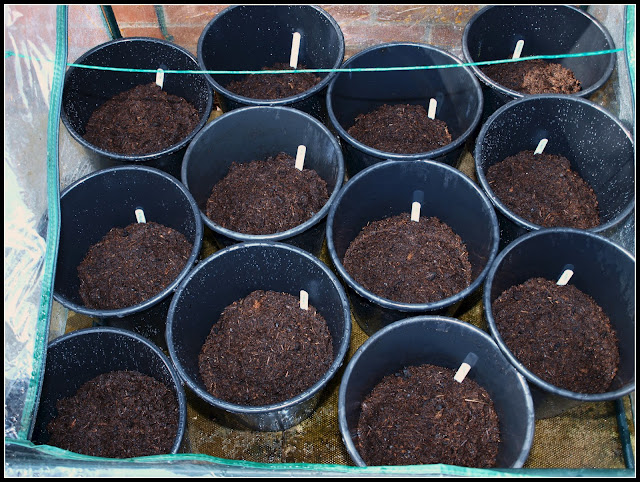You know the term "Busman's holiday", derived from when an off-duty bus-driver would travel by bus? Well, this last weekend was for me a Gardener's holiday. We went over to spend a long weekend with our daughter Fiona and her husband Juan. They live in a village called Ornex, in France but very close to the Swiss city of Geneva, where they both work. Last Summer they bought their first-ever house, and this was our first visit since they moved in. They have already done a lot to improve the interior of the property, which was in a fairly poor condition, but I don't want to write about that. Instead (of course!) I want to tell you about their garden.
The previous occupants of this property were evidently not very good (or ambitious) gardeners. Most of the available garden space is effectively unused. As you can see in my first photo, there is a large expanse of grass (I wouldn't go so far as to call it a lawn), but it is in very bad condition - riddled with moss, etc. We discussed several plans for its future, and they mostly involve the construction of some raised beds (Oh, what a surprise...!), but to be fair I have also advocated retaining a significant expanse of grass for use as family space (on the assumption that grandchildren will appear at some stage, and that barbecue parties will need to be hosted...)
A nice expanse of grass to play with, that's for sure, but what a shame about the view of the electrity pylon, eh? However, look in the other direction, which affords a lovely view of the nearby Jura mountains:
On Saturday morning, about 8 a.m., this was the view from Fiona's kitchen window:
It comprehensively eclipses my view of a tiddly little bed of flowers around the base of one solitary Crab Apple tree, doesn't it?
On Saturday, since the weather was beautiful we set-to and had a blitz on the garden. One of the first tasks we undertook was to re-vitalize the flower-bed alongside the driveway. It contains a number of very mature Rose bushes, which were regrettably in pretty poor condition, having suffered a severe lack of TLC. We pruned the bushes quite hard, hoping that this will revitalise them, and we removed all the extraneous debris that had accumulated over the years, along with a number of very uninspiring Allium plants and countless little seedlings self-seeded from the nearby Ash tree. The only colour to be seen here (indeed in the whole garden) is a lovely clump of Crocuses (foreground, below). I'm sure the Roses will in due course benefit from a good dose of Blood, Fish and Bone, but Rome wasn't built in a day....

Later in the afternoon the youngsters took it in turns beginning to rake moss out of the very neglected "lawn", while I volunteered my services to prepare a Potato bed. (You know my views on lawns and grass...). This is the "Before" situation.

This area had obviously previously been a vegetable bed of some sort, but I don't think it had been used as such in recent years. It was very overgrown and full of weeds like dandelions, chickweeed etc, and stones and general rubbish (especially champagne corks!). Using a lightweight mattock left by the previous owners of the property, I dug over this bed and transformed it into a site for growing potatoes. I felt that this would be a good way of getting a crop under way as soon as possible, and of course the cultivation of potatoes is often seen as a good way of preparing ground for growing other crops, because it breaks down and aerates the soil. Fiona and Juan, who have not previously grown this crop, promptly rushed off to their local Garden Centre to buy some seed potatoes. At this stage of the year there was no choice: there was only one type of seed potato left in the shop. It was a variety I had not heard of before but its description sounded fine - an early, salad variety. I've forgotten the name!

Later, after the gardening was finished for the day we were talking about food (of course) and we were looking at the contents of Fiona's kitchen cupboards. What did we find? None other than
Freekeh. Maybe you remember me writing about this grain the other day when I made Yotam Ottolenghi's dish "Poached chicken with sweet spiced bulgur" (Which originally calls for freekeh instead of bulgur). It was indeed green, as I had read, and it had indeed been obtained from a Lebanese shop in Geneva. Doesn't it look smart displayed on this dish embellished with the silhouette of the New York skyline?
And my UK readers will undoubtedly appreciate this photo of a type of bulgur with the trade name "Tat":
Of course if you are not British, you may not know that "tat" is a colloquial word for "rubbish"!
My birthday was on Monday - 18th March - so while we were over in France we went out for an "official birthday" celebration. We ate in a restaurant just a couple of miles from where Fiona and Juan live, in other words out in the countryside rather than in a town. We were very pleasantly surprised to find a restaurant with a very undistinguished exterior serving really excellent food. Their food was presented very stylishly but without excessive complication - just what I like! One thing we particularly liked was that fact that each dish was presented on a plate appropriate to the dish, rather than being a uniform set of crockery. This meant that a diner eating meat had a plate completely different from the one on which their neighbour might be eating fish. And the plate for the fish was decorated with a fish-related pattern. I'll not bore you with all the details of what we all ate, but I'll just tell you what I had: Starter: green salad with Jambon Cru; Main: beef steak with pepper sauce; Cheese: selection from about 20 different ones on a trolley (including my favourite Brillat-Savarin); Dessert: Creme Brule. Juan has become very knowledgeable about wines, and made some excellent choices for us - a crisp Sancerre for our aperitif, and a lovely smoky red from the Cote Roti for with our mains. I was a happy man!

























































